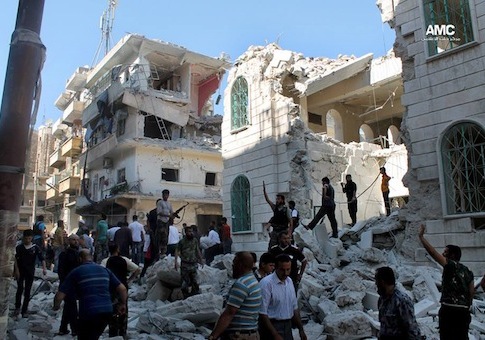Syrian President Bashar al-Assad has run through nearly half his stockpile of advanced Iranian- and Russian-made missiles during his two-year long battle against rebel forces, according to Israel’s leading missile analyst.
Assad has used advanced Russian and Iranian missiles meant to be fired at aircraft and heavy military hardware against the lightly armed rebels, a move that has maximized civilian casualties and decimated villages across Syria.
"People are saying this is conventional war. I find this quite disturbing because [Assad’s] conventional war" is completely asymmetrical, said retired Israeli Brigadier General Uzi Rubin, one of the Jewish state’s foremost missile systems analyst.
More than 100,000 have been killed so far in the war, according to reports.
"You call that a conventional weapon and not a weapon of mass destruction? I find that very disturbing," Rubin said to a room full of government and military officials on Friday morning as he presented a series of pictures showing Assad’s advanced missile stockpile.
"The Iranian connection is very evident," Rubin said, explaining that Tehran has installed production lines in Syria and has supplied Assad with several different types of missiles and launchers.
These advanced weapons have allowed pro-Assad forces to tap into "a formidable, well-balanced missile force" that is resistant to Western counter strikes, according to Rubin, who presented a series of pictures and videos depicting many of Assad’s key missile systems.
As the war drags on, "Syria’s rocket troops have gained valuable experience" with these weapons, Rubin said at a breakfast presentation sponsored by the Air Force Association and expert Peter Huessy.
At the same time, "the Israeli are tracking all the launchers and actually gaining experience from this," he added.
There is evidence that Assad has used an Iranian-designed "Maysalun" rocket that is identical to Iran’s Zelzal-2 system. This is a heavy artillery rocket that is capable of carrying a 1,300-pound warhead.
Rubin also presented evidence of what he called "the real dangerous stuff, " such as advanced guided rockets that closely resemble Iran’s Fateh-110 missiles, which carry half-ton warheads.
Israel is believed to have launched a strike inside Syria in May aimed at destroying these missiles.
Rubin said these missiles are similar to the Russian-made S-300 missiles, which caused a controversy earlier this year when Moscow announced it would send them to Syria.
"Basically, the Russian standoff [over the S-300s] … they don’t need it anymore. They have this," Rubin said.
Syrian military forces have also disguised their missile launchers to look like civilian trucks, according to Rubin.
Many of the launches are Mercedes-Benz Actros model tipper trucks, which are well suited to house the launchers, Rubin said.
"It’s the same ones they use in Iran," he said, explaining that Iranian Mercedes plants are known to build this type of truck.
"All these types are being used against the rebels in large quantities," Rubin added, noting the incredibly high casualty rate in Syria.
The rebels, on the other hand, are ill equipped, using crude hand made rockets and even slingshots to combat Assad’s forces.
Rubin went on to warn that as the world watches Syria, Iran has been quietly ramping up its domestic missile production.
While Iran has outwardly avoided flashy military displays, Rubin aimed to "put to rest some rumors that the Iranian missile program has slowed down" due to sanctions.
"You haven’t heard much about it in the last year, but that doesn’t mean it has slowed down," he said. "It just means you haven’t heard about it."
Iran frequently tests its space launchers, which are believed to be a cover for an intercontinental ballistic missiles program (ICBM). Iran tested a rocket motor with ICBM capabilities in June, as well as a Shahab-3 missile launcher, which can hit targets up to 800 miles away.
"There is no slow down here," Rubin said. "We can put that to rest. It has nothing to do with the sanctions."
